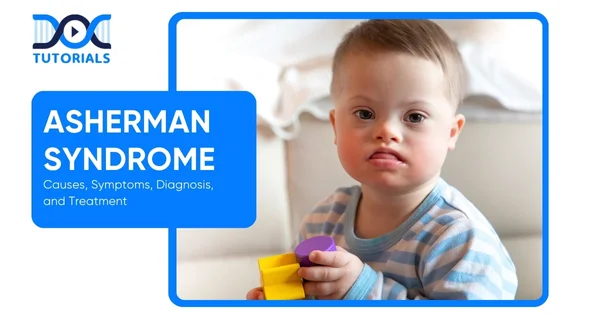Asherman Syndrome: Causes, Symptoms, Diagnosis, and Treatment

Asherman syndrome is a female reproductive system disorder. It occurs when there is scar tissue within the cervix or uterus, which leads to the formation and thickening of fibrous bands, leading to the shrinkage of the uterus. In extreme situations, these bands result in partial or complete uterine wall fusion. It is also referred to as intrauterine adhesions. Due to its tendency to remain undiagnosed, the prevalence of Asherman syndrome is not entirely confirmed.
Recognising the aetiology, signs, and risk factors of this syndrome is essential to facilitate early management and proper long-term care. Also, if you are an aspiring NEET PG medical student, knowing about Asherman syndrome can contribute significantly to your clinical knowledge and patient care.
Keep reading for detailed insight.
What is Asherman’s Syndrome?
If there is the formation of scar tissue within the cervix and/or uterus, the syndrome is known as Asherman’s syndrome, intrauterine adhesions or intrauterine synechiae. These adhesions typically occur with uterine procedures or surgery, such as dilation and curettage (D&C).
Approximately 5 to 39% of women who face recurrent miscarriages are affected by this syndrome. Women who are not trying to conceive might not notice the symptoms or may remain unaware of the condition.
What Causes Asherman Syndrome?
Asherman’s syndrome is a condition produced by the growth of scar tissue (adhesions) within the uterus, shrinking it and, at times, blocking the cervix. This is sometimes due to a number of different factors, although in most instances, uterine or cervical surgery is the most common cause.
The causes of Asherman’s syndrome are:
- Operative Hysteroscopy: A surgical process whereby an endoscope is inserted into the uterus, and fibroids are removed with an electric cutting instrument.
- Dilation and Curettage (D&C): A surgical procedure where the cervix is dilated and tissue is scraped off the uterus. The tissue can be the endometrium, abortion, or miscarriage tissue. Scarring usually does not result unless the procedure is followed by infection.
- Caesarean Section (C-section): This procedure is performed to deliver a baby. Scarring tissue may sometimes develop at the sites of suture if bleeding and infection occur during surgery. However, C-sections rarely cause Asherman’s syndrome on their own.
- Infections: While infections alone rarely cause the condition, having an infection during uterine surgery, such as a D&C or C-section, can lead to scar tissue formation. Infections like cervicitis and pelvic inflammatory disease (PID) are examples.
- Radiation Therapy: Radiation treatment for cervical cancer occasionally results in adhesions (scar tissue) within the uterus, which can give rise to Asherman’s syndrome.
What are the Risk Factors of Asherman’s syndrome?
Asherman’s syndrome is an acquired disorder, i.e., it is a result of some event or surgical intervention leading to tissue scarring. Surgery, infection, and chemotherapy for cancer are the main causative factors.
You are more likely to develop Asherman’s syndrome if you have:
- Had uterine surgery, such as operative hysteroscopy, complicated D&C, or caesarean section.
- Had pelvic infections in the past.
- Had treatment for cancer in the form of radiation therapy.
What are the Symptoms of Asherman’s Syndrome?
The most common symptom of Asherman’s syndrome is the lack of periods. Women may also experience pain during the time when menstruation is expected, yet no bleeding occurs.
Symptoms of Asherman’s syndrome may be:
- Abnormal Menstrual Bleeding: Menstrual periods may be light, irregular, or may not occur.
- Pelvic Pain: Pain or discomfort in the lower abdomen may occur, especially during the period.
- Infertility: Fibrosis will restrict the implantation of embryos, thereby making conception challenging.
- Recurrent Miscarriage: If there has been conception, scar tissue might increase the risk of miscarriage.
The intensity of symptoms depends on the amount of scar tissue. In some cases, women may have no symptoms at all.
What is the Diagnosis of Asherman’s Syndrome?
Your physician will start with a thorough history and physical examination. Physical examinations do not tend to reveal adhesions, but cervical obstruction can be detected if a medical instrument is unable to pass through the cervix.
A blood test may also be advised to rule out other diseases that produce similar symptoms. Ultrasound may also examine uterine lining thickness and follicular growth.
Another approach is to open your cervix and slide in a hysteroscope, a thin, telescope-like instrument. It enables the doctor to look inside the uterus for adhesions. This procedure is called hysteroscopy.
It is also occasionally performed at the time of a hysterosalpingogram (HSG), in which a special fluid dye is instilled into the uterus. The dye outlines an abnormal growth or a blockage within the uterine cavity on an X-ray image.
How is Asherman’s Syndrome Treated?
There are several treatments for Asherman’s syndrome. You will need to talk to your provider about how the condition is going for you, whether you are having pain or discomfort, and whether you have future plans to conceive.
Occasionally, if you are not having any symptoms, treatment might not be needed. However, if you plan to conceive, treatments to remove scar tissue are available. Treatment can also help reduce pelvic pain or cramping.
The main aim of treatment is to eliminate scar tissue and restore the size and form of the uterus to a normal state. Treatment procedures can treat:
- Pelvic pain
- Regularise menstrual cycles
- Improve the possibility of becoming pregnant in premenopausal women
The most frequent method of removing adhesions is hysteroscopy. A hysteroscope is passed through the vagina into the cervix and the uterus, where the scar tissue is carefully removed. One of the complications that may result is inadvertent disruption of regular uterine tissue during the removal of scar tissue.
Oestrogen hormone therapy may be used in conjunction with a small intrauterine catheter placed inside the uterus for a few days after treatment. This keeps the risk of forming new adhesions low. Oestrogen facilitates healing of the uterine lining, while the catheter keeps the anterior and posterior walls apart to avoid adhesion. Antibiotics are administered whenever a catheter is placed to prevent infection.
FAQs About Asherman Syndrome
- How does Asherman’s syndrome lead to miscarriage?
Asherman’s syndrome occurs as a result of scar tissue development in the uterus, which may either partially or totally block the cavity. The adhesions usually hinder a fertilised egg from embedding and developing, resulting in a higher risk of miscarriage.
- Can Asherman’s syndrome lead to heavy bleeding?
Yes. Scar tissue in the uterus can cause thickening of tissues, which break and bleed during menstruation. It can result in an enlarged uterus, cramps, and excessive bleeding.
- What infections cause Asherman’s syndrome?
Infections alone do not often cause Asherman’s syndrome. But when infection comes along with procedures such as a D&C or c-section, adhesions form and result in this syndrome.
- Can I get pregnant after Asherman’s syndrome?
It is possible to become pregnant after treatment. Women with stage II Asherman’s have over a 60% chance of becoming pregnant again. In some rare cases, there will be some mild cramps without bleeding, although this is not typical.
Conclusion
If you are suffering from cramp pain, pelvic pain, or infertility, informing a doctor about your symptoms is wise. Asherman’s syndrome is a treatable condition, and in many cases, symptoms improve significantly after appropriate treatment.
For medical students seeking to crack the NEET PG examination, knowing about issues such as Asherman’s syndrome is important. That is where DocTutorials comes in as your study partner. With professionally conducted video classes, quick revision programmes (QRPs), and in-depth study notes, we lead you to becoming well-prepared for exams and actual clinical scenarios as well.
Discover our NEET PG study materials now and ace your exam!
Latest Blogs
-
-

NEET SS Exam 2024: Analysis, Key Dates, Counselling
The NEET SS 2024 exam kicked off on March 29, 2025. Over two days and two slots, candidates across 13…
-

NEET PG Registration 2025: An Essential Guide For Exam Prep
The NEET PG registration, which is conducted online, is a crucial step in the exam process. Filling out the NEET…





